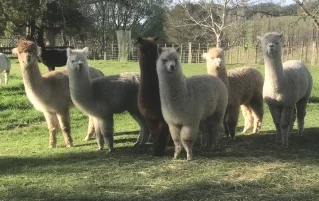
Farm Tours
We offer farm tours for smaller groups and families to meet, feed, interact with and walk with our alpacas.
For full details and to book your experience of these wonderful animals, please go to our reservation form.
Alpacas instinctively do not like to be touched, so training must overcome this. This is a matter of desensitising, a process that involves repeating the same action until the animal is comfortable with it. Training always takes many short, calm sessions and lots of patience and as with all animals, some alpacas are brighter than others and therefore easier to train. This must be allowed for and our experience is that assertive crias do take longer and training males is a bit easier than females. All breeders will have their own techniques for this training and a review of YouTube cria training videos has shown a wide range are used - some much gentler than others. We want our crias to develop a trust with us and over the years have found the following to work at our farm.
From an early age, our practice is to start handling them when they are with their dams in the shelter. Initially, this is simply touching and stroking the neck - this leads to running a hand down their back and after a number of sessions, there is a level of trust and the cria can be caught and gently held. Catching and holding is needed early on to inject vaccines, vitamin D etc, discussed on this website in Alpaca Welfare. Touching and rubbing the head, lips and ears can then begin and it’s sometimes possible to discover that the cria has a particular spot they enjoy being rubbed! Being able to touch all parts of the head is important, not only for halter fitting but also should a vet need to examine the eyes or the mouth. If the animal is taken to a show, the teeth to hard palate alignment will be assessed by the judge so you must also be able to part the lips. When this point is reached, the halter can be introduced to the cria.
We start with simply allowing it to see and smell the halter but in later sessions we touch it against the nose and face without actually fitting it. Only when there is no avoidance of the halter is it placed over the nose - raising it from beneath the cria's head rather than lowering it from above. If the cria is calm when the halter nose band is rested on the upper nose, it is buckled up for a short period otherwise more sessions will be needed. The halter must be appropriately sized and correctly adjusted - if it is not and restricts nasal breathing, the cria will panic and then be fearful of the halter. It is advisable to re-check the tightness as thicker fleece behind the head may give the impression that the halter is correctly fitted. However, the neck band may settle into the fleece and the halter will loosen off.
The touching and rubbing of the crias body should eventually extend to down the legs to the feet - this is useful as it makes their examination and future toenail trimming much easier. By six to eight months, your cria should be easy to halter and be comfortable standing still on a lead.
The literature below can be accessed by clicking on the highlighted link. This will access the appropriate web page from which the article can be downloaded but may immediately start downloading the full reference.
57. Windschnurer, I., Fischer, L., Yanagida, T., Eibl, C., Franz, S. and Waiblinger, S. (2021). Caretaker attitudes and animal training are associated with alpaca behaviour towards humans - An online survey. App. Anim. Behav. Sci., 236, 1093-1097